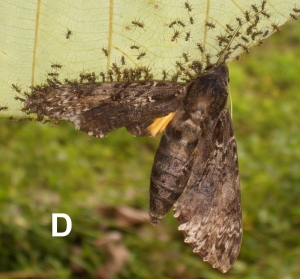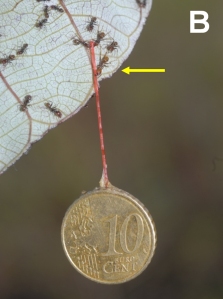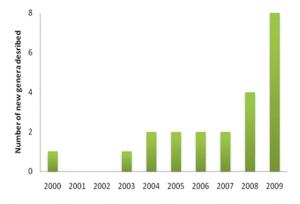Filed under: Uncategorized
Reading scientific articles is part of scientist every day job. I have to say that if I find that many papers can be classified as interesting for my research, but not necessarily exciting to read (even sometimes boring). The goal of a scientific article is not be exciting but to be useful, to make a point. Having undergraduate students working around, it is easy to tell that they are not extremely enthusiast about reading scientific articles in general. However, once in a while, some exciting papers are published that, I believe, will enthusiast most of their readers and could become one of those examples that professors can then use to explain a concept to their students. Students that could even enjoy them!
On arboreal ants, I can think about a few like this that came out over the past years such as the gliding Cephalotes and the red berry Cephalotes (infected by a nematode) of Steve Yanoviak, the devil gardens of Myrmelachista of Frederickson, or the trapping techniques of Allomerus by Dejean. In a new article, still by Dejean and collaborators published in PlosOne, ants reveal one more time some really cool example of adaptations to capture prey. Like the three previous examples, arboreal ants are involved. In this case, Azteca species use the structure of the leaves of their host plant to capture preys… huge preys! Up to 13000 times their own weight. And the authors to compare this with a 70 kg human being able to capture a 935 tons prey.
Wait a second, 935 tons… what could weight that much? That is about eight Boeings 757 full of passengers, or also the weight of a destroyer during the Second World War… Amazing!
The pictures provided in the article are great and talk for themselves. Also, do not miss the video in the supplement (it has the quality of a documentary).
Now the interest of the article is also to show that the relation between the plant species and the ant species is fundamental for the success of prey capture, as well as the side of the leaf used by ants to capture large sized prey. This provides a good example of the different benefits perceived by ants on different myrmecophytic plants.
Here is the link to the article:
http://www.plosone.org/article/info:doi/10.1371/journal.pone.0011331
Enjoy!
Filed under: Uncategorized
This is the first post for this new Year 2010, so let’s go back in the past, you know those old time of 2009, or even 2008. But first of all, I wish you an excellent new year, with I hope tons of discoveries and exciting ant projects .
Recapitulate what happens in 2009 for ant genera discoveries.
As we say for wine, 2008 was a “grand cru”, well 2009 was a “cru exceptionnel”!
For those of you who are also wine lovers, you might have heard that the wine production last year in France is supposed to be exceptional (un cru exeptionnel in French)!
Well, 2009 was not only a great year for French wine bottles but also for ant new genera descriptions!
The graphic below represents the number of new genera described each year from 2000 to 2009 (2009 should have 9 genera and not 8).
From 2000 to 2007, about zero to two new genera maximum per year have been described. And then, we had a first burst in 2008 with 4 new genera (including one new sub-family, Martialinae)! But that’s nothing beside the big bang of 2009 and its 9 new genera. So what is happening and who are the newbie’s and the resurrected genera?
Well, first it seems that a new prolific and very nice generation of new myrmecologists is arriving and they are eager to let their mark in myrmecology, while at the same time some more established myrmecologists have continued their great work.
The year 2008 saw the arrival of Feroponera and Promyopias Bolton & Fisher in Africa (the later been resurrected);Opamyrma Yamane et al. in Vietnam; and the new subfamily Martialinae and genus Martialis Rabeling et al. from Brazil.
The year 2009 has Kalathomyrmex and Paramycetophylax Klingerberg & Brandao from South America (the later been resurrected); Tropidomyrmex Silva et al. (2009) also from South America; Aptinoma and Ravavy Fisher (2009) from Madagascar; Austromorium Shattuck from Australia; Diaphoromyrma Fernandez et al. from Bahia (Brazil ); andPropodilobus Branstetter from Borneo.
Finally, I just found out yesterday the description of a new genus from Taiwan (or I should say from an island just beside Taiwan) by M. Terayama and called Formosimyrma (Myrmicinae).
So the total for 2009 is 7 new Myrmicine genera and 2 new Dolichoderine genera.
So 9 new genera descriptions to beat in 2010. It seems that this new year is starting well with the split of Paratrechinainto 3 genera: Paratrechina, Parapatrechina and Nylanderia (see next post) by LaPolla and collaborators.
So as a summary for 2009:
– Most genera described were Myrmicinae (7/9).
– South America (4/9), Asia (2/9), Madagascar (2/9) and Australia (1/9) are the regions that contributed to new ant genera description.
– The journal Zootaxa has become the main journal for generic description/revision of ant taxa (8 genera on 9 described in this journal)
Some of those changes are already online on Ant Genera of the World, and the rest will come with very soon (with the next big update of our website in the coming weeks)
References:
Bolton B., and B.L. Fisher . 2008. Afrotropical ants of the ponerine genera Centromyrmex Mayr, Promyopias Santschi gen. rev. and Feroponera gen. n., with a revised key to genera of African Ponerinae (Hymenoptera: Formicidae).Zootaxa 1929: 1-37.
Branstetter M.G. 2009. The ant genus Stenamma Westwood (Hymenoptera: Formicidae) redefined, witha description of a new genus Propodilobus. Zootaxa 2221: 41-57.
Fernandez F., J.H.C. Delabie, and I.C. do Nascimento. 2009. Diaphoromyrma, a new myrmicine ant genus (Hymenoptera: Formicidae) from North Eastern Brazil. Zootaxa 2204: 55-62.
Fisher B.L. 2009. Two new dolichoderine ant genera from Madagascar: Aptinoma gen. n. and Ravavy gen. n. (Hymenoptera: Formicidae). Zootaxa 2118: 37-52.
Klingenberg C., and C.R.F. Brandao. 2009. Revision of the fungus-growing ant genera Mycetophylax Emery and Paramycetophylax Kusnezov rev. stat., and description of Kalathomyrmex n. gen. (Formicidae: Myrmicinae: Attini). Zootaxa 2052: 1-31.
LaPolla J.S., S.G. Brady, and S.O. Shattuck. 2010. Phylogeny and taxonomy of the Prenolepis genus-group of ants (Hymenoptera: Formicidae). Systematic Entomology 35: 118-131.
Rabeling C., J.M. Brown, and M. Verhaagh. 2008. Newly discovered sister lineage sheds lighton early ant evolution.PNAS 105 (39): 14913-14917.
Shattuck S.O. Austromorium, a new myrmicine ant genus from Australia (Hymenoptera: Formicidae). Zootaxa 2193: 62-68.
Silva R.R., R.M. Feitosa, C.R.F. Brandao, and J.L.M. Diniz. 2009. Tropidomyrmex elianae, a new myrmicine ant genus and species from Brazil, tentatively assigned to Solenopsidini (Hymenoptera, Formicidae). Zootaxa 2052: 32-48.
Terayama M. 2009. A synopsis of the family Formicidae of Taiwan (Insecta; Hymenoptera). The Research Bulletin of Kanto Gakuen University 17: 81-266.
Yamane S., T.V. Bui, and K. Eguchi. 2008. Opamyrma hungvuong, a new genus and species of ant related toApomyrma (Hymenoptera: Formicidae: Amblyoponinae). Zootaxa 1767: 55-63.


